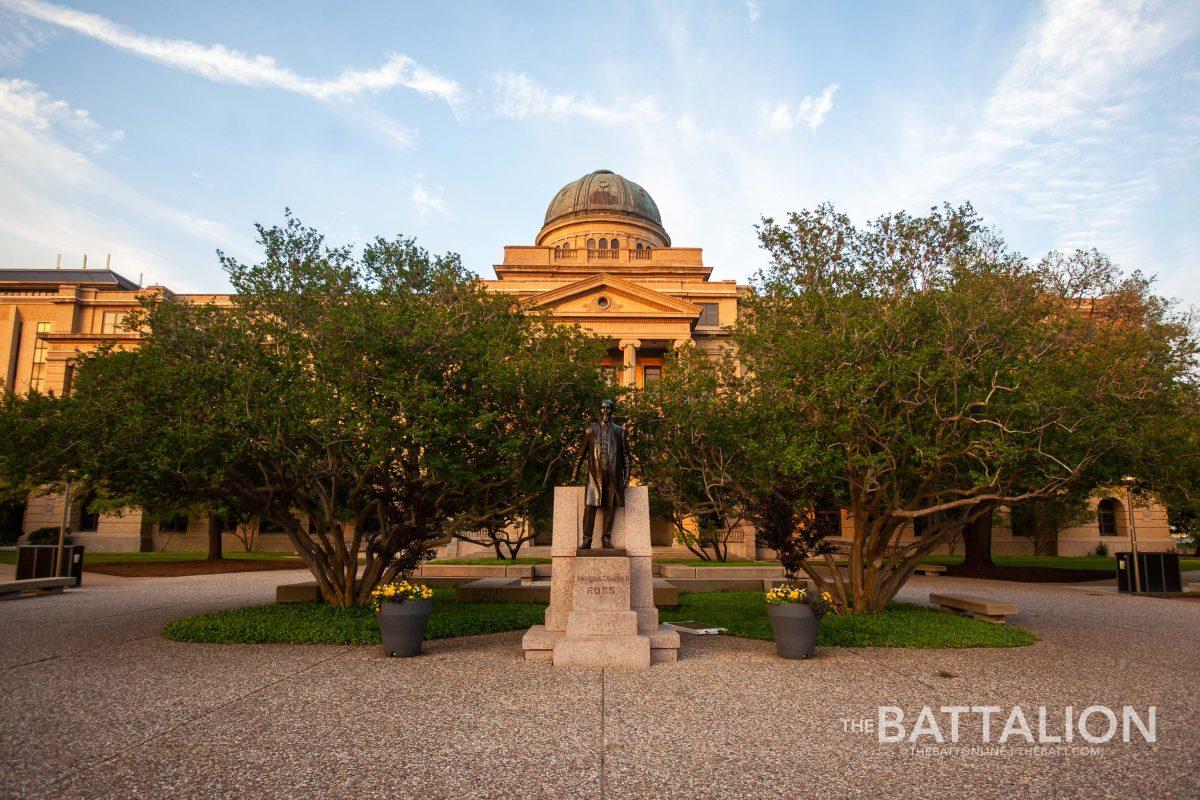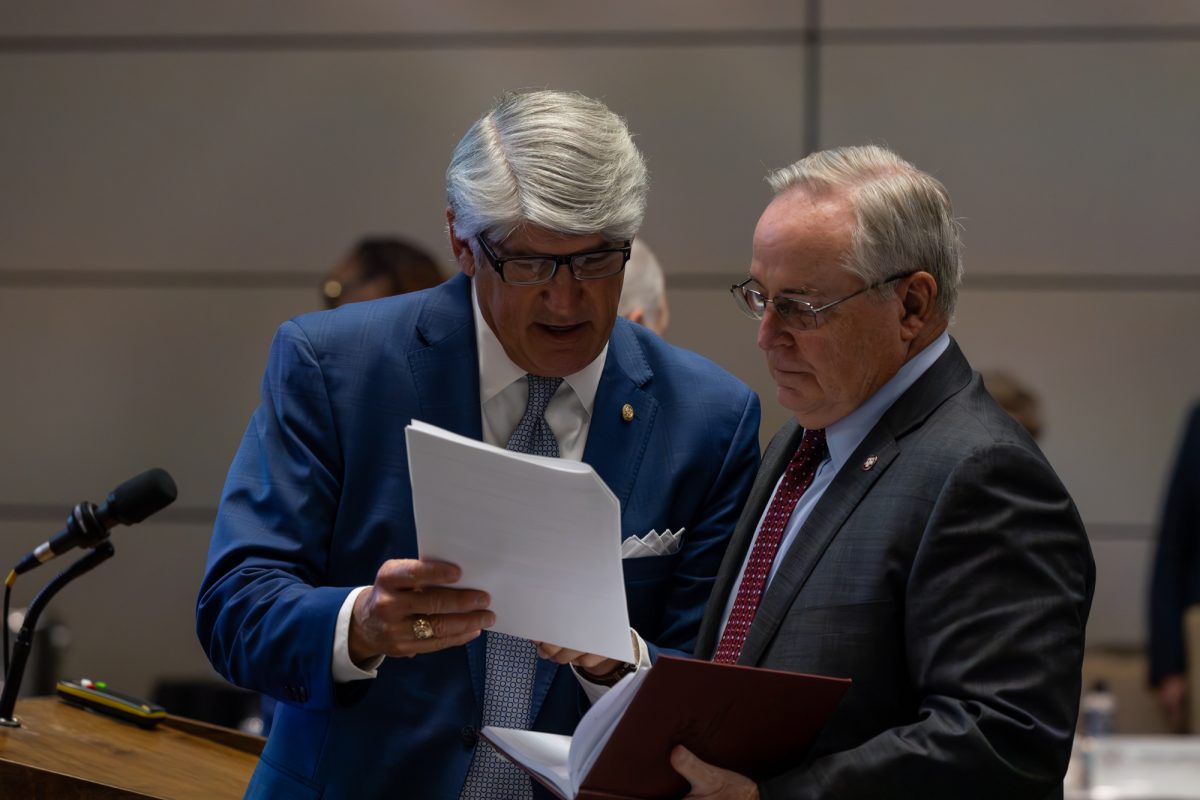Petitions are currently circulating through the A&M student body arguing for and against the removal of the Lawrence Sullivan “Sully” Ross statue from its place in Academic Plaza.
Sully’s history
Sully Ross, who served as 19th governor of Texas, is honored for the significant improvements he made to A&M while president of the formerly named Agricultural and Mechanical College of Texas from 1891 to 1898. Some of the actions for which Sully is revered for while serving as president include improving campus resources, expanding campus infrastructure with new buildings and increasing enrollment.
Sully’s statue was commemorated in 1918, making it the oldest statue on campus. Over time, it has become an Aggie tradition for students to lay pennies at the feet of the monument before exams for good luck.
However, many students believe it is time to recognize Sully’s ties to the Confederacy, which they say outweigh any of his positive achievements. Cushing Librarian and Curator of Africana Resources Rebecca Hankins said some people believe A&M needs to look past Sully’s negative history for the sake of maintaining tradition. However, she said she has a serious problem walking past a statue of a man who was a part of a system that wanted to enslave her ancestors.
“A lot about tradition and the things that Aggies celebrate are deep in parts of history that have been really problematic,” Hankins said. “You have people who cling to [traditions], but you need someone strong enough to say ‘this is painful.’”
Petition for the statue’s removal
The initial petition demanding A&M leadership remove the statue from its place in Academic Plaza was created on June 2 and has already garnered over 18,000 signatures. The petition was created in the wake of George Floyd’s death and the surge of protests around the country in support of the Black Lives Matter movement.
“While Sully made strong contributions to Texas A&M, he served as a Confederate General, saw Blacks as inferior, did not support integration, and was against women’s suffrage,” the petition states. “It’s long overdue for the statue to be removed. This is the way that we as Aggies can contribute to changing the cultural landscape of our university.”
Jordan Vick, political science junior and College of Liberal Arts senator, said the student body senate has begun drafting legislation around the petition to persuade university leadership to consider the removal of the statue from Academic Plaza. Vick said the senators working on the resolution have decided to ask university leadership to move Sully’s Statue into Cushing Library.
“The point isn’t to completely erase history,” Vick said. “We just don’t want this person to be honored as a hero figure. We want it to have context surrounding it so we know A&M doesn’t support this figure anymore.”
Petition to keep the statue
Another group of students quickly created a counter-petition on June 4 to keep the Sully statue, which has already garnered over 16,000 signatures. The petition highlights many of Sully’s contributions to the university.
“Texas A&M prides itself in its esteemed traditions and history, and Sully represents both,” the petition states. “The selfless service Ross provided to our school and our state is thankless, and the least we can do is preserve the humble statue which stands on our campus and serves as the cornerstone of many Aggie traditions.”
University studies senior Connor Miller said he supports the petition to keep Sully’s statue because he represents selfless service. Miller said he believes the statue has never signified anything other than the Aggie Core Values.
“It would be foolish to ignore that he was a Confederate general,” Miller said. “However, that’s not all I see when I look at his statue. I also see a man who fought for women to be able to take classes here and a governor who enforced peace for four months between white supremacist democrats and black men who had retained power in Fort Bend County.”
Experts weigh in
Hankins said The Daughters of the Confederacy are responsible for many of the Confederate memorials still seen across the South today. During post-Civil War Reconstruction, she said members of the Daughters of the Confederacy joined the legislatures across the South with the mission to change the narrative behind the Confederacy. They had laws passed, monuments built and textbooks changed to alter the way the Confederacy was remembered, Hankins said.
“They were very successful, but that doesn’t mean we don’t know the real history of the Confederacy,” Hankins said. “It’s not as if we just don’t know these things, it’s just that they don’t matter. They don’t matter because black people don’t matter.”
Racism researcher, author and distinguished sociology professor Joe Feagin said that in addition to Sully’s Statue, there are a number of buildings on campus that people have suggested should be removed or renamed because they honor archsegregationists or Ku Klux Klan members.
“It’s 2020,” Feagin said. “It’s time to quit celebrating the traitors of the Confederate Army and the Confederate system.”
Feagin, whose research interests include racial and ethnic studies, said the underlying issue with these petitions is symbolism and the university must consider what it is trying to symbolize through the monuments on campus.
“Are you going to symbolize a diverse democracy?” Feagin said. “A boldly racial and gendered democracy? Or are we going to keep celebrating elite white men, some of whom have a very disturbing history?”
Assistant Vice President for Diversity Jennifer McGee Reyes, Ph.D., said in an email statement to The Battalion that the Office for Diversity respects the students who have decided to join communities around the nation in addressing oppressive symbols.
“The Office for Diversity appreciates that our students are leading with respect and inclusion,” McGee Reyes said. “With the leadership of our students and examples of our [Southeastern Conference] and [Association of American University] peers, Texas A&M has an opportunity to meet the challenges of our past and emerge as leaders in inclusion, anti-racism, and belonging.”
Sharp doubles down
Many students have reached out to President Michael K. Young and Chancellor Sharp directly asking for the statue’s removal. On June 5, Sharp replied to several students with a letter he wrote to The Battalion in 2018 in response to a letter to the editor that suggested Sully had ties to white supremacy.
In his letter, Sharp said these claims were false, stating that Sully was praised as “perhaps the best friend black Texans ever had” by first Prairie View A&M Principal Edward L. Blackshear in a Dallas Morning News article from 1897.
“He had NO ties to white supremacy as the writer wrongly asserts,” Sharp said in the statement. “Lawrence Sullivan Ross will have his statue at Texas A&M forever, not because of obstinance, but because he deserves the honor with a lifetime of service to ALL TEXANS and ALL AGGIES.”
The Chancellor’s Office said in a follow-up email to The Battalion that sending the almost two-year-old letter was a clerical error. When asked if Sharp would like to issue an updated statement on the situation, The Battalion was told Sharp stands by his 2018 position.
So, what do we do with Sully?
Hankins and Feagin both said they believe Sully’s Statue should be removed from its place in Academic Plaza and placed into the Cushing Library Archives. Hankins said she is encouraged by students petitioning to remove Sully’s statue, but it is ultimately up to the Board of Regents, the President and the Association of Former Students to reevaluate the monuments on our campus.
“You need to get people in place who are willing to evaluate what the monuments mean and how they represent a painful history,” Hankins said. “I don’t think it’s going to happen unless you have a President, Board of Regents and Association for Former Students saying these are the conversations that we need to have, and this is what we are going to do to make this right.”
Feagin said that after Sully’s statue is placed in the Archives, its spot should be filled by a statue commemorating Matthew Gaines. Feagin said Gaines was a key player in getting A&M started, and he represents the future of the diversity of A&M’s student body, faculty and staff.
“Sully, who’s an archsegregationist — a racist — should be in a museum somewhere with Hitler and all the other disturbing people who have lived on this planet,” Feagin said. “There’s no reason why y’all can’t put pennies on a Gaines statue.”
Editor’s Note: Information provided by Jordan Vick has been edited for clarity and the information she has provided to The Battalion is not on behalf of the Student Senate.
Answering the call: What to do about Sully
June 9, 2020
Photo by Photo by Meredith Seaver
Petitions have been created for the removal and against the removal of the Lawrence Sullivan Ross statue in Academic Plaza.
0
Donate to The Battalion
$2065
$5000
Contributed
Our Goal
Your donation will support the student journalists of Texas A&M University - College Station. Your contribution will allow us to purchase equipment and cover our annual website hosting costs, in addition to paying freelance staffers for their work, travel costs for coverage and more!
More to Discover










